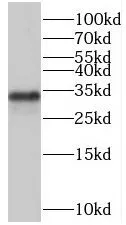FGFR1 antibody - 100 µg
Host : Mouse
Clonality: Monoclonal
Clone: 8D2
Isotype: IgG2a
Immunogen: fibroblast growth factor receptor 1
Purity: ≥95% as determined by SDS-PAGE
Form: Liquid
Molecular weight: 90 kDa
Uniprot: P11362
Gene id: 2260
Background: Tyrosine-protein kinase that acts as cell-surface receptor for fibroblast growth factors and plays an essential role in the regulation of embryonic development, cell proliferation, differentiation and migration. Required for normal mesoderm patterning and correct axial organization during embryonic development, normal skeletogenesis and normal development of the gonadotropin-releasing hormone(GnRH) neuronal system. Phosphorylates PLCG1, FRS2, GAB1 and SHB. Ligand binding leads to the activation of several signaling cascades. Activation of PLCG1 leads to the production of the cellular signaling molecules diacylglycerol and inositol 1,4,5-trisphosphate. Phosphorylation of FRS2 triggers recruitment of GRB2, GAB1, PIK3R1 and SOS1, and mediates activation of RAS, MAPK1
ERK2, MAPK3
ERK1 and the MAP kinase signaling pathway, as well as of the AKT1 signaling pathway. Promotes phosphorylation of SHC1, STAT1 and PTPN11
SHP2. In the nucleus, enhances RPS6KA1 and CREB1 activity and contributes to the regulation of transcription. FGFR1 signaling is down-regulated by IL17RD
SEF, and by FGFR1 ubiquitination, internalization and degradation.
Field of research: Signal Transduction, Metabolism, Cardiovascular, Immunology, Cancer, Developmental biology, Neuroscience, Stem Cells
Storage conditions: PBS with 0.02% sodium azide and 50% glycerol pH 7.3, -20°C for 12 months(Avoid repeated freeze
thaw cycles.)
Applications: ELISA, WB, IHC, FC
Dilution: WB: 1:500-1:5000; IHC: 1:50-1:500
Target: FGFR1
Purification: Protein A+G purification
Reactivity: Human

Clonality: Monoclonal
Clone: 8D2
Isotype: IgG2a
Immunogen: fibroblast growth factor receptor 1
Purity: ≥95% as determined by SDS-PAGE
Form: Liquid
Molecular weight: 90 kDa
Uniprot: P11362
Gene id: 2260
Background: Tyrosine-protein kinase that acts as cell-surface receptor for fibroblast growth factors and plays an essential role in the regulation of embryonic development, cell proliferation, differentiation and migration. Required for normal mesoderm patterning and correct axial organization during embryonic development, normal skeletogenesis and normal development of the gonadotropin-releasing hormone(GnRH) neuronal system. Phosphorylates PLCG1, FRS2, GAB1 and SHB. Ligand binding leads to the activation of several signaling cascades. Activation of PLCG1 leads to the production of the cellular signaling molecules diacylglycerol and inositol 1,4,5-trisphosphate. Phosphorylation of FRS2 triggers recruitment of GRB2, GAB1, PIK3R1 and SOS1, and mediates activation of RAS, MAPK1
ERK2, MAPK3
ERK1 and the MAP kinase signaling pathway, as well as of the AKT1 signaling pathway. Promotes phosphorylation of SHC1, STAT1 and PTPN11
SHP2. In the nucleus, enhances RPS6KA1 and CREB1 activity and contributes to the regulation of transcription. FGFR1 signaling is down-regulated by IL17RD
SEF, and by FGFR1 ubiquitination, internalization and degradation.
Field of research: Signal Transduction, Metabolism, Cardiovascular, Immunology, Cancer, Developmental biology, Neuroscience, Stem Cells
Storage conditions: PBS with 0.02% sodium azide and 50% glycerol pH 7.3, -20°C for 12 months(Avoid repeated freeze
thaw cycles.)
Applications: ELISA, WB, IHC, FC
Dilution: WB: 1:500-1:5000; IHC: 1:50-1:500
Target: FGFR1
Purification: Protein A+G purification
Reactivity: Human

